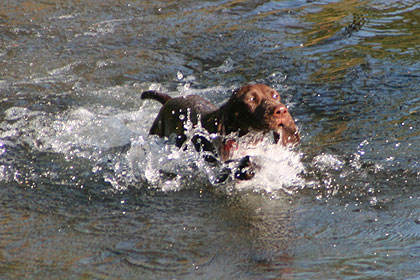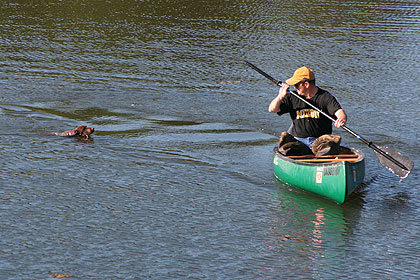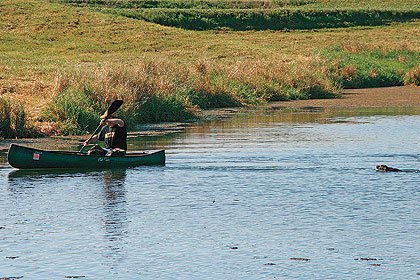It's the perfect warm weather training exercise.
By Bob West
Wow! We're into the warmer months, and daytime temps are high enough that we must be cautious of heat-related problems during field work. So this might be a good time to spend some of our training sessions on water work€¦but hold on now; don't jump to the next article just because you have a pointing dog!
 Warm, shallow water is your best choice for pup's first experience, and you should never push or force him in. A better idea is leaving him on one side of a small pool or shallow creek while you wade to the other side. Most pups will soon be splashing after you. |
Water work is important for all hunting dogs, and the vast majority enjoy it and do a pretty respectable job on water retrieves once they've been introduced and trained properly.
I'm not saying your pointer can be expected to manage a bunch of tough retrieves in a below-freezing duck marsh, but you should be able to count on him when a downed quail or pheasant lands in the creek or pond. Beyond that, swimming is a great means to provide low impact exercise, especially with its cardiovascular and respiratory benefits.So let's tackle the idea of accustoming your new pup or young dog to water. If you have an older dog, these same suggestions will work there also.
Once you pup is old enough to get around the field pretty well and shows strong interest in retrieving a training dummy or ball, you're probably ready to move on to water introduction.
Hopefully you have access to a pond or open marsh area that's free of trash or stumps full of fishing lures--an area that's safe for you and your dog, in other words.
One more thing--you should plan on getting wet in the process. During this initial introduction to water it's best for you to go wading with the pup.
 After your dog is comfortable splashing around in the shallows and you feel he's ready for a swim, leaving him standing on shore while you paddle out a short distance usually does the trick. His desire to be with you soon overcomes any fear of the water, and before you know it he's swimming after you. |
Beginnings Wading out some distance in warm shallow water is an ideal beginning, and playing with a ball or training dummy, teasing your dog to follow, is a great way to get him pumped up and build his confidence. You might play like this for several minutes or even on a number of separate occasions before you feel he's really comfortable in shallow water.
The next step is to tie a length of light cord to your training dummy, then go back to the shallow water. Get your dog revved up with the dummy again, tossing it for short exciting retrieves. Toss the dummy a little farther each time, watching to make sure the dog stays wound up about the game--you want him really excited before going to deeper water for the actual swim.
(Why the light cord tied to the dummy? If your pup doesn't chase the dummy, drag it back quickly and toss it a shorter distance; your objective is keeping him pumped and excited about the chase.)
Swimming is a pretty big step for your pup. When dogs have their footing with all four feet on firm ground, they feel in control and comfortable. But now we're setting them up to make a decision requiring a certain level of drive along with the self-confidence to leave that secure footing and launch themselves into this new, strange, and possibly scary environment.
With this in mind it's your call when to do this, but once you have your dog excited and on the way, toss the dummy out to swimming depth water, just a little ways at first. If the dog swims or splashes his way out to the dummy but doesn't pick it up, pull it back with the cord and give him a couple more short retrieves in the shallow water, again revving him up and taking his mind off the swim.
 Make sure your pup doesn't catch up to you and try to clamber aboard. After a short swim circle back to shore so he learns to get out of the water on his own. This really builds confidence and you'll usually find your pup ready to go again. |
If your dog stays interested in retrieving you might try another swim, but if not, play in the shallow water with him and quit on a high note, planning to come back another day.
Above all, never ever throw your pup into deeper water or force him to swim; he has to do it on his own willingly.
Developing the drive
What I suggest for those dogs who don't go swimming after trying the above scenario is for you to take off for the other shore, leaving the pup alone on the bank. You'll need a small boat or canoe and access to your training pond when no one else is around, dogs or people.
Simply sit the pup on the bank by himself and paddle away, again calling his name. Sometimes splashing the dummy in the water helps get him excited enough to follow, but most often it's the fact he just doesn't want to be left behind that overcomes his fear.
Next thing you know, here he comes, splashing and barking after you.
Remember I mentioned earlier that it takes a combination of the pup's innate drive/desire and self-confidence to overcome his apprehension and jump into this new scary environment. In our first scenario we relied on both, with self-confidence playing a major role. In the second scenario we used nature to build the pup's desire/drive to a point of overcoming his lack of confidence.
By repeating this, his confidence builds, and all of a sudden the pup realizes, hey, I can do this!
Learn to land
Don't let the pup catch up to the boat, but circle around and head back to shore ahead of the pup so he can land himself. Once he does, you can give some "high fives" and maybe a few splashing retrieves in the shallow water to emphasize the fun part of things.
We don't want the pup to catch the boat because he'll tend to claw for the side of the boat with his front feet, causing his body to go vertical and possibly submerge. It's best you make a circle, allowing the pu
p to enter and exit the water on his own and realizing, hey, I'm in control here. Again, this reinforces his confidence in this new strange element.
Each subsequent swim can be longer, and with this behind you, you'll likely be able to go back to the shallows and work on the play retrieving.
As your pup gains more and more confidence in the water you can move to longer retrieves. This in turn improves your chances of getting that odd bird that fell across the creek, or in the middle of the pond, back to hand.






